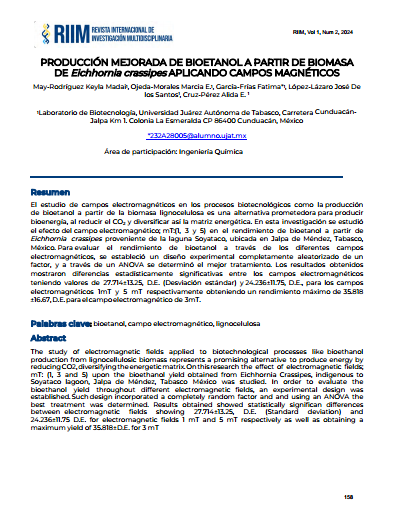Producción mejorada de bioetanol a partir de biomasa de eichhornia crassipes aplicando campos magnéticos
Keywords:
Bioethanol, Electromagnetic field, LignocelluloseAbstract
The study of electromagnetic fields applied to biotechnological processes like bioethanol production from lignocellulosic biomass represents a promising alternative to produce energy by reducing CO2, diversifying the energetic matrix. On this research the effect of electromagnetic fields; mT: (1, 3 and 5) upon the bioethanol yield obtained from Eichhornia Crassipes, indigenous to Soyataco lagoon, Jalpa de Méndez, Tabasco México was studied. In order to evaluate the bioethanol yield throughout different electromagnetic fields, an experimental design was established. Such design incorporated a completely random factor and and using an ANOVA the best treatment was determined. Results obtained showed statistically significan differences between electromagnetic fields showing 27.714±13.25, D.E. and 24.236±11.75 D.E. for electromagnetic fields 1 mT and 5 mT respectively as well as obtaining a maximum yield of 35.818±D.E. for 3 mT
References
O. Khan, A. K. Yadav, M. E. Khan, and M. Parvez, “Characterization of bioethanol obtained from Eichhornia Crassipes plant; its emission and performance analysis on CI engine,” Energy Sources Part a Recovery Utilization and Environmental Effects, vol. 43, no. 14, pp. 1793–1803, Aug. 2019, doi: 10.1080/15567036.2019.1648600.
B. Holmatov, J. F. Schyns, Krol, P. W. Gerbens-Leenes, and A. Y. Hoekstra, “Can crop residues provide fuel for future transport? Limited global residue bioethanol potentials and large associated land, water and carbon footprints,” Renewable and Sustainable Energy Reviews, vol. 149, p. 111417, Oct. 2021, doi: 10.1016/j.rser.2021.111417.
T. J. Tse, D. J. Wiens, and M. J. T. Reaney, “Production of Bioethanol—A review of factors affecting ethanol yield,” Fermentation, vol. 7, no. 4, p. 268, Nov. 2021, doi: 10.3390/fermentation7040268. [4] U. F. Carreño-Sayago and C. Rodríguez-Parra, “Eichhornia crassipes (Mart.) Solms: an integrated phytoremediation and bioenergy system,” Revista Chapingo Serie Ciencias Forestales Y Del
Ambiente (En Línea)/Revista Chapingo Serie Ciencias Forestales Y Del Ambiente, vol. 25, no. 3, pp. 399–411, Aug. 2019, doi: 10.5154/r.rchscfa.2018.06.051.
L. M. Madikizela, “Removal of organic pollutants in water using water hyacinth (Eichhornia crassipes),” Journal of Environmental Management, vol. 295, p. 113153, Oct. 2021, doi: 10.1016/j.jenvman.2021.113153.
N. Politaeva y V. Badenko, “Magnetic and electric field accelerate Phytoextraction of copper Lemna minor duckweed”, Plos one, 2021. https://doi.org/10.1371/journal. pone.0255512
Norma Oficial Mexicana, NOM-126-ECOL-2000 Establece las especificaciones para la realización de actividades de colecta científica de material biológico de especies de flora y fauna silvestres y otros recursos biológicos en el territorio nacional.
Norma Oficial Mexicana, NMX-AA-003 Aguas residuales- muestreo, 1980.
Norma Oficial Mexicana NMX-AA-038-SCFI-2001. Análisis de agua –Determinación de turbiedad en aguas naturales, residuales y residuales tratadas
Norma Oficial Mexicana NMX-AA-073-SCFI-2001 Análisis de agua - Determinación de cloruros totales en aguas naturales, Residuales y residuales tratadas - Método de prueba, 2001.







